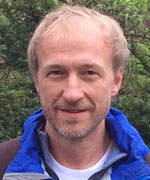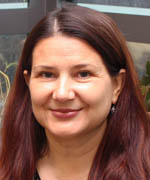Colleagues: Recently Tenured
LISA CUNNINGHAM, PH.D., NIDCD
Senior Investigator; Chief, Section on Sensory Cell Biology, National Institute on Deafness and Other Communications Disorders

Education: University of Tennessee, Knoxville, Tenn. (B.A. and M.A. in audiology); University of Virginia, Charlottesville, Va. (Ph.D. in neuroscience)
Training: Clinical fellowship in audiology at Indiana University Medical Center (Indianapolis); postdoctoral fellowship in auditory neuroscience at the University of Washington (Seattle)
Before coming to NIH: Assistant professor at the Medical University of South Carolina (Charleston, S.C.)
Came to NIH: In 2011
Selected professional activities: Organizer, Association for Research in Otolaryngology Symposium “Supporting Cells: Lessons from Studies of Glia”; class dean, NIH-Oxford-Cambridge Scholars Program; Graduate Partnership Program; NIH CSR Study Section service
Outside interests: Bicycling; hatching a plan to buy an RV
Web site: https://irp.nih.gov/pi/lisa-cunningham
Research interests: My research focuses on the mechanosensory hair cells in the inner ear that are responsible for normal hearing and balance functions. Specifically, my lab and I are interested in the molecular signals that regulate the survival, health, and death of these cells. Mammalian hair cells are not regenerated after they die, so in humans these cells must survive and function for up to a century in order to transduce sound and head movement into the neural signals of hearing and balance. During this lengthy period of time, hair cells may encounter many potentially toxic stresses, including exposure to excessive sound and/or to therapeutic drugs with ototoxic side effects. Hair cells must be able to respond rapidly and effectively to such cytotoxic stimuli if they are to survive and continue to function over the course of a lifetime.
Two major research areas are being investigated in my lab. From a basic science perspective, we are interested in the cellular and molecular mechanisms that determine whether a hair cell under stress ultimately lives or dies. From a clinical and translational perspective, we are examining how we can use the basic science of hair-cell death and survival to guide the rational development of clinical therapies aimed at preventing hearing loss in humans.
We have shown that stress-induced production of heat-shock proteins protects the inner ear against otherwise-lethal stresses. More recently we have shown that a neighboring cell type, the glia-like supporting cells, can protect sensory hair cells from dying. Our work indicates that supporting cells are important determinants of the fate (life or death) of hair cells under stress.
Currently the major translational goal in the lab is to develop clinical therapies that prevent hearing loss in patients who are receiving ototoxic drugs, such as aminoglycoside antibiotics or cisplatin. These are important drugs that save many lives, but they also result in permanent hearing loss in a significant portion of the patients who receive them. We are examining methods of protecting the hearing of these patients without interfering with the therapeutic benefit of the drugs themselves.
ELISSA LEI, PH.D., NIDDK
Senior Investigator, Laboratory of Cellular and Developmental Biology, National Institute of Diabetes and Digestive and Kidney Diseases

Education: The University of Texas at Austin, Austin, Texas (B.S. in molecular biology); Harvard Medical School, Boston (Ph.D. in cell and developmental biology)
Training: Postdoctoral fellow, Johns Hopkins University (Baltimore)
Came to NIH: In 2006
Outside interests: Attending opera; playing volleyball and tennis
Web site: https://irp.nih.gov/pi/elissa-lei
Research interests: The work we perform in my laboratory will help determine how the three-dimensional organization of DNA within each cell affects cellular function and identity throughout an organism’s development. In particular, we focus on chromatin insulators—complexes of DNA and protein that influence gene expression by establishing chromatin domains subject to transcriptional controls.
Loss of insulator activity can result in substantial positive or negative changes in gene expression, culminating in disease, defects in development, and/or death. For example, the deletion of insulator binding sites has been implicated in the congenital growth disorder Beckwith-Wiedemann syndrome and a rare type of kidney cancer called Wilms’ tumor.
Because chromatin insulators exist and function similarly in most multicellular animal organisms, we use the relatively simple fruit fly Drosophila melanogaster as a model. The Drosophila system is extremely powerful for genetics as well as for biochemistry and cell biology techniques. Furthermore, the Drosophila genome has the largest diversity of known chromatin-insulator proteins.
We strive to understand the mechanisms by which chromatin insulators are regulated by RNAs and RNA-binding proteins. We made the striking finding that certain messenger RNAs (mRNAs) associate stably with insulator complexes within the nucleus. We speculate that these mRNAs also harbor a noncoding function such as acting as a scaffold for insulator complexes at specific subnuclear locations.
We also uncovered an RNA interference-independent role for the Argonaute 2 protein in promoting chromatin-insulator activity. Moreover, we identified two RNA-binding proteins as the first known tissue-specific regulators of insulator activity. We hope to move the field forward by achieving a better understanding of the mechanisms of chromatin-insulator function, including the identification of novel interactors and regulatory steps.
MARTIN MEIER-SCHELLERSHEIM, PH.D., NIAID
Senior Investigator; Chief, Computational Biology Section, Laboratory of Systems Biology, National Institute of Allergy and Infectious Diseases

Education: University of Konstanz, Konstanz, Germany (Bachelors Degree in Physics); University of Hamburg, Hamburg, Germany (M.S. in physics; Ph.D. in physics)
Training: postdoctoral training in the Laboratory of Immunology, NIAID
Before coming to NIH: Research assistant at the University of Hamburg
Came to NIH: In 2001
Outside interests: Spending time with his kids; playing guitar; playing a variety of sports
Web site: https://irp.nih.gov/pi/martin-meier-schellersheim
Research interests: When discussing models of cellular behavior, many people refer to computational or mathematical modeling approaches. And indeed, when applied carefully (with a good sense of what is physiologically reasonable), such quantitative techniques can give us insights that go beyond what we could understand based on intuition and experimentation alone.
Before a computational model of a cell-biological process can be built, however, there has to be a set of hypotheses or a qualitative model about the workings underlying the observed behavior. Every biologist continuously creates and tinkers with such qualitative models because they are the frameworks that guide experimental work.
My colleagues and I found that, frequently, much information is lost when these qualitative models (based on experience, literature research, and intuition) are translated into quantitative, computational ones. Sometimes the computational models turn into overly simplified (some would say grotesque) caricatures of what the original set of hypotheses incorporated. This loss of information is mainly due to the technical challenges associated with developing good computational models.
To address this problem, my group has developed software, called Simmune, that even researchers with no prior experience in modeling can use. Simmune enables researchers to translate their hypotheses about molecular mechanisms underlying cellular signaling processes into quantitative simulations that can even take into account specific cellular morphological features. The software uses iconographic symbols—for cells, molecules, and their binding sites and interactions—and translates them into computational models whose behavior can be explored in various ways through accessible graphical interfaces.
LUDMILA PROKUNINA-OLSSON, PH.D., NCI-DCEG
Senior Investigator, Laboratory of Translational Genomics, National Cancer Institute–Division of Cancer Epidemiology and Genetics

Education: Moscow State University, Moscow, Russia (M.Sc. in molecular genetics); Uppsala University, Uppsala, Sweden (Ph.D. in medical genetics)
Training: Visiting fellow with Francis Collins in NHGRI; research fellow in NCI-DCEG’s Laboratory of Translational Genomics
Came to NIH: In 2005 for training; became a tenure-track investigator in 2010
Selected professional activities: Editorial board member for Cancer Research and the Journal of Interferon and Cytokine Research; preceptor for the Introduction to Cancer Research Careers Program for and the Community College Enrichment Program of NIH
Outside interests: Knitting and sewing
Web site: https://irp.nih.gov/pi/ludmila-prokunina-olsson
Research interests: Recent genome-wide association studies (GWAS) have identified multiple common inherited genetic susceptibility factors that may play a role in a variety of human diseases including cancers. The primary goal of my research is to identify the functional links between these genetic associations and molecular phenotypes, interpret genetic susceptibility, and develop precision-medicine tools based on genetic information.
Some genetic variants can affect coding sequences and lead to disease-causing changes in proteins, whereas other variants identified by GWAS are noncoding variants that regulate the function of important genes.
My laboratory is conducting follow-up studies on findings from several GWAS including bladder, breast, and prostate cancers as well as cancer-related outcomes of viral infections. We use a wide range of genetic and functional methods to identify molecular interactions within the genome, including DNA sequencing and genotyping, RNA sequencing, protein-expression studies, DNA-protein interaction analysis, cell culture, and epigenetic studies.
The post-GWAS work on bladder cancer has identified several novel molecular mechanisms of bladder cancer susceptibility and a genetic variant upstream of a cyclin E gene as the first germline genetic marker associated with the risk of development of clinically aggressive disease.
Persistent infection with hepatitis C virus (HCV) is a primary etiological factor for the development of chronic liver disease, including cirrhosis of the liver and cancer. After a recent GWAS on HCV clearance, we discovered a novel human interferon (IFN-lambda-4) that is created by a novel genetic variant. This discovery has explained the initial GWAS association, provided a novel genetic test for selection of treatment options for HCV, and suggested IFN-lambda-4 as an important player in clearance of HCV and other infections and cancer progression. I am interested in further translational development of these findings.
RAJESHWARI SUNDARAM, PH.D., NICHD
Senior Investigator, Biostatistics and Bioinformatics Branch, Division of Epidemiology, Statistics and Prevention Research, Eunice Kennedy Shriver National Institute of Child Health and Human Development

Education: University of Calcutta, Kolkata, India (B.Sc. mathematics); Indian Statistical Institute, Kolkata (M.Stat. in applied statistics and data analysis); Michigan State University, East Lansing, Mich. (Ph.D. in statistics)
Before coming to NIH: Assistant professor, Department of Mathematics, University of North Carolina (Charlotte, N.C.)
Came to NIH: In 2006
Selected professional activities: Associate editor, Biometrics
Outside interests: Cooking; hiking
Web site: http://www.nichd.nih.gov/about/staff/Pages/bio.aspx?nih_id=0012729610
Research interests: I am developing improved statistical methods for the analysis of biomedical data. In particular, I am interested in survival analysis, a method in which we examine and model the time it takes for events to occur.
I have been the lead statistician in several reproductive epidemiology studies, including the Longitudinal Investigation of Fertility and the Environment. These studies have focused on time-to-pregnancy and other reproductive outcomes associated with pregnancy. I have been developing survival-analysis methods to better model time-to-pregnancy while meaningfully accounting for the underlying biological factors and processes. I have developed joint models for various longitudinally developed biomarkers (namely, menstrual cycle patterns, intercourse, and fecundity) with a view toward creating risk calculators for subfertility and infertility.
I am also interested in developing methods to incorporate high-dimensional exposures in the survival model that would help assess the effect of highly correlated exposures, for example, the effects of environmental toxicants and pollutants on fecundity and other time-to-event outcomes. In addition, I am using multivariate survival-analysis methods to address various issues around the progression of labor in pregnant women and the progression of disease in general.
Read this section in upcoming issues of The NIH Catalyst to learn about other recently tenured colleagues, including:
- Swee Lay Thein (NHLBI)
- Jon Lorsch (NICHD)
- Hannah Valantine (NHLBI)
- Charles Venditti (NHGRI)
- George Koob (NIDA)
- Philip Bourne (NLM-NCBI)
- Keir Neuman (NHLBI)
- Hormuzd Katki (NCI-DCEG)
- Histaka Kobayashi (NCI-CCR)
- Deborah Citrin (NCI-CCR)
- Xiaoling Li (NIEHS)
- Edward Ginger (NINDS)
This page was last updated on Monday, April 25, 2022
